Issue 1, 2023
Nuclear physics in Russia is 100 years old
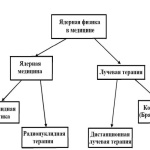
Nuclear physics in Russia is 100 years old
A. P. Chernyaev, E. N. Lykova
The review presents a brief history of the development of nuclear physics since the beginning of the 20th century. The most significant applications of nuclear physics discoveries in the world economy are described. Analysis of the current implementation of nuclear physics achievements in the national economy of Russia is carried out and the development prospects are considered. The most striking nuclear projects in Russian science and technology are discussed.
Show AbstractTesting of Threshold SiO$_2$-Aerogel Cherenkov Detectors Using Cosmic Rays
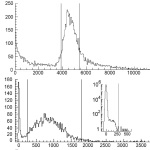
Testing of Threshold SiO$_2$-Aerogel Cherenkov Detectors Using Cosmic Rays
A. M. Lapik, L. Z. Dzhilavyan
A method for testing threshold SiO$_2$-aerogel Cherenkov detectors using cosmic radiation is described. The implementation requires a minimal amount of additional electronics and does not involve massive absorber layers (such as lead, etc.). The method allows for accurate determination of the efficiency of the investigated detectors and for the study of the detectors’ operation in different energy intervals for relativistic particles.
Show AbstractContacts for SiC nano-microwatt energy converters
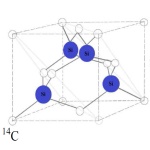
Contacts for SiC nano-microwatt energy converters
A. V. Gurskaya$^5$, M. V. Dolgopolov$^{1,2}$, S. A. Rajapov$^3$, V. I. Chepurnov$^4$
The aim of the study is to consider the features of the physico–chemical processes in the near-contact region of the semiconductor SiC phase doped with radionuclide by solid-phase diffusion of 14 C atoms, generation of nonequilibrium carriers and the semiconductor phase distinctive characteristic features. The DFT approach in this paper is aimed at obtaining evidence of the vacancy mechanism of diffusion during the formation of the SiC phase in the Si wafer. Radionuclide and silicon atoms counter-diffuse through a growing layer of silicon carbide, forming layers by solid-phase chemical transformation of silicon of n - or p -type conductivity into heterostructures of anisotypic or isotypic type of conductivity relative to the SiC phase, with superstecheometric alloying with conservation of the valence and the type of impurity conductivity, forming, depending on the phase, effects energetically manifested as the effect of ‘‘the inner sun,’’ which is the source of electrons and electron–hole pairs at ionization losses. This is due to interactions with the electrons of the shells of neighboring atoms, leading to the formation of electrons and holes in the region of spatial charge and carrying by built-in electric fields. The purpose of the study is due to an increase in the efficiency of separation of electron–hole pairs.
Show AbstractSimulation of a proton beam facility in the TOPAS MC software package
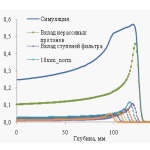
Simulation of a proton beam facility in the TOPAS MC software package
G. V. Merzlikin$^{1,2}$, S. V. Akulinichev$^{1,3}$, I. A. Yakovlev$^{1,3}$
The aim of this work is to simulate the formation system of therapeutic proton beams at the accelerator of the Institute of Nuclear Research, Russian Academy of Sciences, using the TOPAS MC software package and to calculate, on this basis, the characteristics of irradiation of biological objects. As such characteristics, the dependence of the absorbed dose and linear energy transfer (LET) on the proton range in water and the effective dose of irradiation of HT-29 and HCT-116 cell lines used in real experiments are considered. Also, the uniformity of irradiation with a high dose rate of the studied biological objects was evaluated during the operation of the radiation unit in FLASH-therapy modes. The research is aimed at preparing and conducting radiobiological experiments with proton beams with a record dose rate.
Show AbstractDetection of Radon Decay Using the LVD Setup for Searching Neutrinos
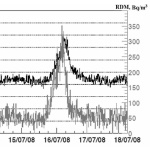
Detection of Radon Decay Using the LVD Setup for Searching Neutrinos
N. Yu. Agafonova$^1$, E. A. Dobrynina$^2$, N. A. Filimonova$^3$
The Large Volume Detector (LVD), located in the low-background laboratory of Gran Sasso, Italy, was designed to detect neutrinos from stellar core collapses in our Galaxy. The search for rare events requires careful attention to the experiment’s background, such as the natural radioactivity of rocks and detector materials, as well as the interaction of underground cosmic-ray muons. The LVD setup is capable of detecting gamma quanta from the decay of radon daughter nuclei. We convincingly demonstrate a correlation between the variation in the count rate of background pulses from gamma quanta in the detector and the variation in the concentration of radon nuclei in the experimental hall. We also point out the existence of another source of radon concentration variation — seismic activity.
Show AbstractVelocity distributions of forward moving fragments in heavy-ion collisions at Fermi energies.
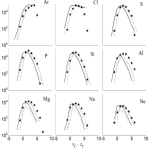
Velocity distributions of forward moving fragments in heavy-ion collisions at Fermi energies.
T. I. Mikhailova, E. -. Batchuluun, Yu. M. Sereda
Heavy-ion-induced projectile fragmentation reactions at Fermi energies are of interest to investigate the properties of nuclei far from the valley of stability, nuclear potentials and to get knew knowledge about nuclear equation of state. Isotopes far from stability line can be useful for various applications. It is therefore of interest to predict relative yields of isotopes and their energies. Here we treat such reactions in a microscopic approach, which consists of several steps: initialization of ground states of the colliding nuclei, dynamical evolution until the freeze-out point where the primary fragments can be identified, calculation of the excitation energy of the primary fragments, and their de-excitation. For the dynamical evolution we use a Boltzmann--Vlasov type transport equation, and for the de-excitation a statistical multi-fragmentation description. We apply this approach to collisions of projectile nuclei $^{40}$Ar on target $^9$Be at energy 36.5 A MeV, calculate isotope distributions and velocity spectra of the produced isotopes and compare the results of our calculations to experimental data obtained at COMBAS set-up in JINR
Show AbstractA novel approach for taking into account the zero-point oscillations in calculating heavy-ion fusion cross-sections
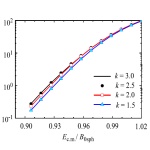
A novel approach for taking into account the zero-point oscillations in calculating heavy-ion fusion cross-sections
M. V. Chushnyakova$^1$, I. I. Gontchar$^2$
Earlier in the literature it was shown that accounting for the zero-point oscillations (ZPO) of the shape of colliding atomic nuclei results in significant increasing of the calculated sub-barrier capture (fusion) cross-sections. However, calculations of such kind were performed in a simplified way with the schematic nucleus-nucleus potential. The purpose of the present paper is to estimate in an accurate way the sub-barrier capture cross-sections in collisions between oxygen-16 and spherical nuclei with the realistic potential and to compare the calculated cross-sections with the experimental data. Nucleus-nucleus potential is obtained within the double-folding model with Paris M3Y nucleon-nucleon effective forces. The nucleon densities are taken from the IAEA data base (they are calculated using the Hartree-Fock-Bogoliubov method and approximated by two-parameter Fermi profile). The transmission coefficients are calculated within the WKB approximation below the Coulomb barrier and within parabolic barrier approximation above it. A novel approach for taking into account the ZPO without any fitting parameters is proposed. It is demonstrated that ignoring the ZPO results in underestimating the experimental data whereas accounting for ZPO improves the agreement of the calculated cross-sections with the experimental ones.
Show AbstractBeam dynamics simulation in the linear accelerator used as an injector for the fourth generation Specialized Synchrotron Radiation Source SSRS-4
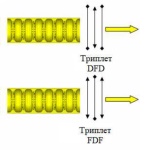
Beam dynamics simulation in the linear accelerator used as an injector for the fourth generation Specialized Synchrotron Radiation Source SSRS-4
I. A. Ashanin, Yu. D. Kluchevskaia, S. M. Polozov, V. I. Rashchikov
At present, a fourth-generation synchrotron radiation source USSR (Synchrotron & Laser), which will the one of the world's largest scientific centers is being designed in Russia. Its creation will make it possible to carry out experiments to study the structures of a wide range of objects in various disciplines at a qualitatively new level compared to the previous generation of sources. The overall facility layout includes a 6 GeV main storage ring and a linear electron accelerator (linac) at full energy. It is proposed to use one linear accelerator with two RF guns. A RF gun with a photocathode can be used to generate a bunch train for a Free Electron Laser (FEL), a RF gun with a thermionic cathode can be used for injection into a storage ring. Both injectors will operate with the same regular part of the linear accelerator, consisting of 100-120 identical sections. The purposed transverse emittance in the main storage ring will be 50-100 pm rad. The development of a general linear accelerator scheme in order to minimize the beam energy spread and the output transverse emittance, the optimization of the geometric and electrodynamics parameters of the accelerating structures, and the beam dynamics analysis in this linear accelerator will be discussed in the article. The beam dynamics simulation was performed using the BEAMDULAC code developed at the Department of Electrophysical Facilities of the National Research Nuclear University MEPhI.
Show AbstractOptimization of electrodynamic characteristics of the linear electron accelerator at an energy 8-50 MeV with injection from an electron source based on cluster plasma systems
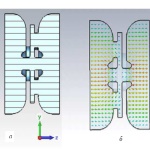
Optimization of electrodynamic characteristics of the linear electron accelerator at an energy 8-50 MeV with injection from an electron source based on cluster plasma systems
I. A. Ashanin, Yu. D. Kluchevskaia, S. M. Polozov, V. I. Rashchikov
One of the key problems of contemporary accelerator physics has been an increase of the rate of the energy gain in linear electron accelerators. The physical limits of the accelerating field intensity for the normal and superconducting accelerating structures have been practically reached; therefore, new acceleration schemes are being considered, primarily acceleration in plasma and wakefield acceleration. It is suggested to consider an opportunity using of a bunch generated in a laser-plasma channel for injection into a traditional metal structure. It has been shown that an electron source based on a cluster plasma can generate a short (from 0.1 to 1.0 ps) electron bunch with an energy of several hundred keV, which makes it possible to consider such a source as an alternative to a photocathode. Next, the beam must be captured in the acceleration mode and accelerated up to an energy of 50 MeV with the possibility of energy tuning. The features of such accelerator, the features of the electron bunch capturing in the acceleration mode, and the possible values of the energy spectrum in such a system will considered. The features of such a source, including the possible energy spectrum, the features of the electron bunch capturing with an extremely wide spectrum in the acceleration mode, as well as the electrodynamic characteristics of the accelerating structures are considered in the paper. The beam dynamics simulation was carried out using the BEAMDULAC package developed at the Department of Electrophysical Facilities of the National Research Nuclear University MEPhI. The main results of the optimization of electrodynamic characteristics of the accelerating structures was also reported.
Show AbstractMEPHI’S OPTION OF LAB SCALE COMPTON SOURCE
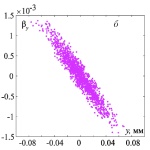
MEPHI’S OPTION OF LAB SCALE COMPTON SOURCE
V. S. Dyubkov, S. M. Polozov, V. I. Rashchikov
A development and construction of comparatively cheap and compact (several meters scale) X-ray sources is possible with the help of inverse Compton backscattering of laser photons on an electron bunch. Such sources can be used in the field of materials science (new materials, diagnostics of nanostructures at the atomic level), research of nano- and biosystems, medicine and pharmacology (new drugs R&D), physics and chemistry of fast-flowing processes (burning, explosion). It is suggested that compact storage synchrotron will operate with normal conducting S-band top-up linac. Linac will provides bunches with tunable energy in the range of 20-60 MeV to generate the photon flux with tunable energy. The use of a storage ring provides the following advantages: comparatively high average intensity of the generated photon flux, high brightness, photon beam energy tuning in a wide range, high degree of monochromaticity and coherence of the generated photons. There are current results of the design of a compact storage ring for generating the photons in the energy range of 5-45 keV and investigations of the development of relativistic picosecond electron beam dynamics instabilities in the report.
Show AbstractCompton desintegration of positronium
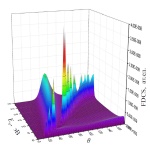
Compton desintegration of positronium
I. S. Stepantsov$^1$, I. P. Volobuev$^2$, Yu. V. Popov$^{2,3}$
We study the Compton disintegration of positronium in comparison with the same of hydrogen. The initial photon energy of a few keV allows one to apply the non-relativistic approach and use A^2 approximation. Interesting features in the behavior of various differential cross sections are observed. In particular, the conditions were found, under which the electron and positron move parallel to each other with equal velocities. This leads to a number of specific Coulomb resonances.
Show AbstractContinuous-wave electron linacs for science and industry
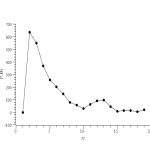
Continuous-wave electron linacs for science and industry
D. S. Yurov, V. I. Shvedunov, A. S. Alimov
We present a brief overview of continuous-wave accelerators for both nuclear physics research and applied purposes, including superconducting accelerating systems. We also propose results of calculations for a new 1 MeV 175 kW continuous-wave linac developing at SINP MSU.
Show AbstractEffect of the Flat-Top Resonance System of DC-280 Accelerator on a Charged Particle Beam
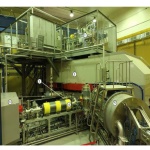
Effect of the Flat-Top Resonance System of DC-280 Accelerator on a Charged Particle Beam
V. P. Igorevih, A. A. Protasov, V. A. Semin, I. V. Kalagin, K. A. Varlamov, D. S. Yakovlev, V. I. Mironov
Experiments on the synthesis of superheavy elements (SHE) performed at the Flerov Nuclear Reactions Laboratory (FLNR) have shown that the probability of a single SHE event occurrence range from one event per month to one event per week. Currently, the heaviest element synthesized in reactions with $^{48}$Caa is an element with Z=118 (Oganesson). To synthesize new SHEs, it is necessary to use heavier bombarding particles such as $^{50}$Ti, $^{54}$Cr, $^{58}$Fe, etc. In experiments with heavier particles, the cross-section for SHE isotope production is expected to be lower than that in the case of using $^{48}$Ca. This implies that an increase in the intensity of the bombarding ion beams is necessary to collect experimental statistics within a reasonable time frame. Thus, for the synthesis of superheavy elements at the FLNR of the Joint Institute for Nuclear Research (JINR), the Superheavy Element Factory was created. The basic setup of the Factory is the cyclotron complex DC-280, which allows for the production of high-intensity beams of accelerated ions. As the beam intensity increases, the energy spread also increases. To minimize this process, the DC-280 cyclotron is equipped with an additional flat-top accelerating system.
Show AbstractRecent progress in description of NN scattering with the dibaryon model of nuclear forces
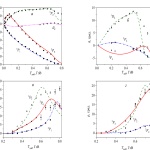
Recent progress in description of NN scattering with the dibaryon model of nuclear forces
O. A. Rubtsova, V. N. Pomerantsev, M. N. Platonova
The recent results in description of elastic and inelastic nucleon-nucleon scattering within the dibaryon model of nuclear forces are reviewed. This original model taking into account non-nucleonic degrees of freedom is based on the special mechanism including an exchange by an intermediate six quark state. A good description of the partial phase shifts and inelasticities is found for the main lowest partial NN configurations in a wide energy range from zero up to 0.6-1 GeV. The model gives the resonances in each NN configuration as well which parameters are compared with the data found from recent experiments on single- and two-pion production and partial wave analyses.
Show AbstractCollisional quenching of the pionic helium $^4$He long-lived states
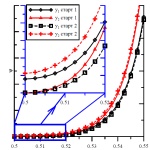
Collisional quenching of the pionic helium $^4$He long-lived states
A. V. Bibikov, G. Y. Korenman, S. N. Yudin
Collisions of metastable pionic helium atoms with helium atoms of the medium lead to the destruction of these states, as well as to the shifts and broadening of E1 spectral lines of transitions between the pionic helium states. In the paper, in order to obtain the interaction potential matrix ($\mathrm{\pi^-He}^+) \mathrm{He}$, calculations of the potential energy surface (PES) in the unrestricted Hartree-Fock method are performed taking into account electron correlations within the second-order perturbation theory (MP2). With this potential, the system of equations of strong channel coupling is solved numerically. Various techniques are used in the calculations that eliminate degeneracy of the solution matrix in the vicinity of small distances between colliding subsystems, which arises due to strong coupling of channels in this region, owing to which the numerical solutions ``forget'' boundary conditions. Cross sections and rates of collisional transitions are calculated ($N \sigma v$). It is found that the collisional transition rate $(n, l) = (17, 16) \rightarrow (17, 15)$ ($n, l$ --- the principal quantum number and the angular momentum respectively) for the density of the medium $N = 0.2 \times 10^{23} \, \mbox{cm}^{-3}$ is lower than $10^3 \, s^{-1}$, which indicates that it is possible to ignore the effect of collisional destruction of pionic helium long-lived states in precision laser spectroscopic experiments.
Show AbstractInfluence of Nuclear Potential Diffuseness on the Neutron Halo Structure in Zr Isotopes near the Neutron Drip Line
Influence of Nuclear Potential Diffuseness on the Neutron Halo Structure in Zr Isotopes near the Neutron Drip Line
O. V. Bespalova$^1$, A. A. Klimochkina$^2$, M. M. Mosunov$^3$
The predictive calculations of the single-particle halo structure in Zr isotopes near the neutron drip line have been carried out using the dispersive optical model. The influence of the expected increase in the diffuseness parameter of the nuclear potential for neutron-excess nuclei on the mean square radii of halo states and their populations has been investigated. A significant difference has been shown between the number of neutrons in halo states and the number of neutrons in the region r>12 fm where there is no spatial correlation between halo neutrons and the nuclear core.
Show AbstractEnergy estimates for $2^+_1$, $4^+_1$, $6^+_1$ states in heavy and superheavy nuclei
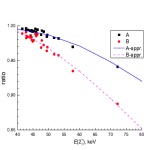
Energy estimates for $2^+_1$, $4^+_1$, $6^+_1$ states in heavy and superheavy nuclei
A. D. Efimov$^1$, I. N. Izosimov$^2$
Based on the available energy correlation deformation and the lowest excitation energy, estimates were obtained for the energy of the $2^+_1$-- states. The considered systematics of the energy ratios in the rotational band also made it possible to obtain estimates for the $4^+_1$ and $6^+_1$-- states. A comparison with the results of other works was carried out.
Show Abstract
